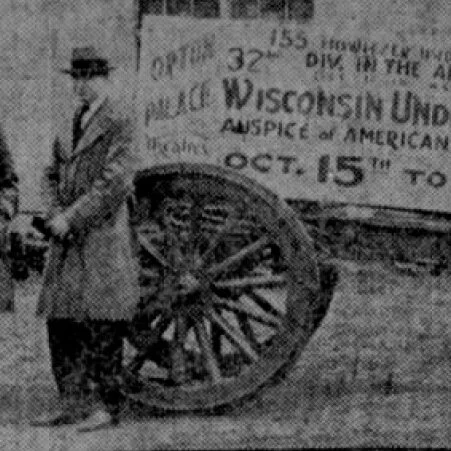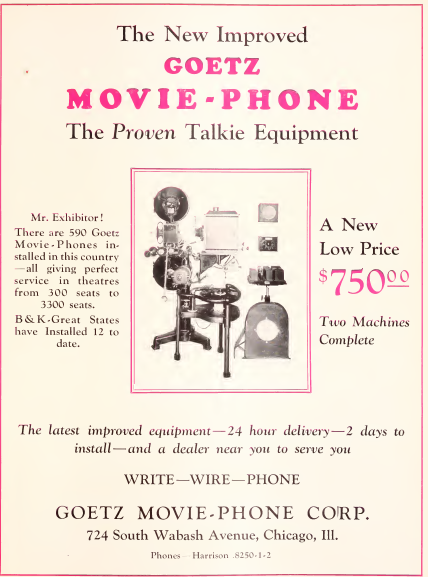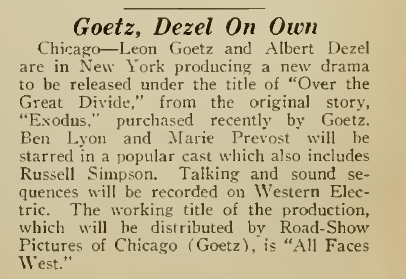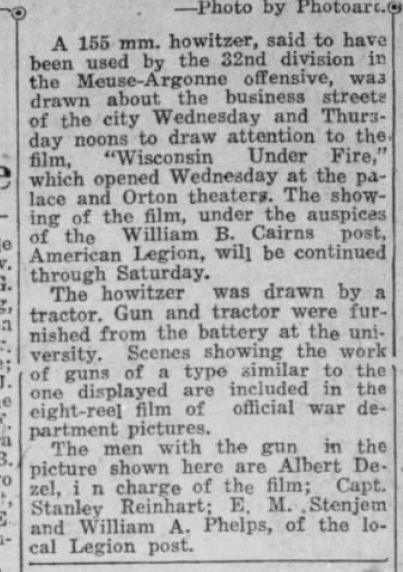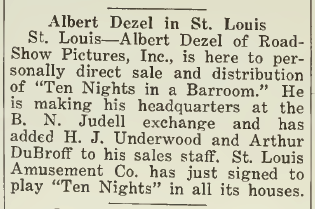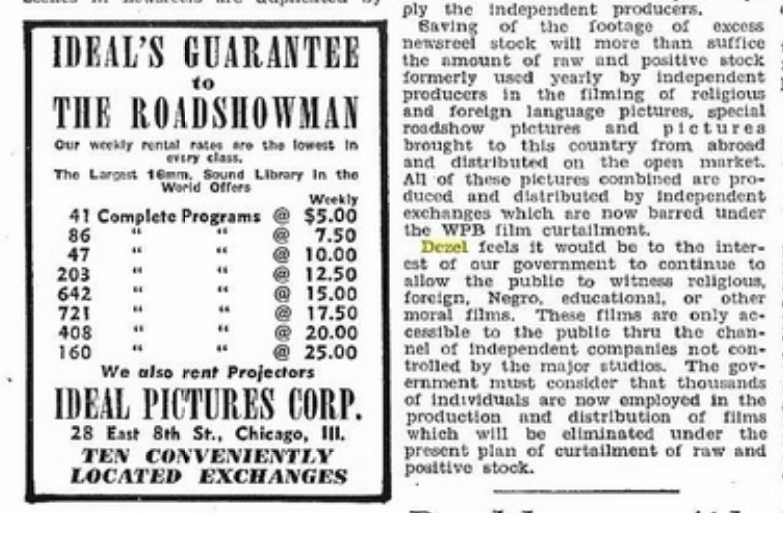Albert Dezel and Road Show Pictures, Inc.
1927 was a hellish year for the Goetz Brothers. Early that Sping, they’d invested heavily into Milwaukee’s urban theater market— four separate theaters in just a few months— and had been badly burned by September. There were simply too many theaters catering to inner city workers and the brothers were forced to sell their new properties back to previous owners. In at least one instance the brothers went into partnership with the previous owner (after having sold the theater back) and poured even more money into renovating the aging house.
In addition to the Milwaukee purchases, Chester Goetz had become general manager of a concern called “United Theaters” which operated movie houses in Kenosha, Beloit and Jefferson, Wisconsin. Of course, the brothers still had their houses in Watertown, Plattville, Au Claire and Chippewa Falls. (They sold their Ironwood, MI interest in January prior to the Milwaukee splurge.)
Cash must have been tight by Fall 1927, and this post is about what Leon Goetz did to remedy the situation. That November he embarked on a questionable scheme: he invested in a traveling pornography movie show with road-show impresario, Sint Millard. By March 28th 1928, Leon was suing Sint for defrauding his company, “U.S. Health Films, Inc.” of $25,000. Some agreement must have been reached, because Sint Millard was still road-showing “Pitfalls of Passion” in 1929.
Stepping back from the Goetz/Millard legal dispute, for Leon “road shows” were (allegedly) a return to his theater roots. Prior to casting his lot in with the Gruwells sometime around 1914, Leon is supposed to have toured the Midwest as a traveling movie projectionist— a road showman. Leon was in his late teens/early twenties during this alleged “road show” stint, for which I’ve found no evidence beyond oral tradition. My hunch is that the “road show” story has its roots in Leon’s Millard connection, which happened when Leon was 36 years old and had already been run out of Monroe. What was the “road show” business like?
Historian of film pornography Dave Thompson has this to say about road-showing:
Nobody knows the name of the first man to bundle a few ten-minute reels and a portable projector into his Model T and drive out into the wilderness in search of people to screen them for. More than likely , he was either the same person, or an associate of the same person, who made the films in the first place...Word of mouth took over. The next time our man passed through that town or one of the neighboring communities, he might find the local Shriners or Elks awaiting him, to ask if they could possibly rent his services for the evening. A college fraternity would hear the whispers and make their own arrangements, and then spread the news back to the students' hometowns.
Soon, our man could be making a comfortable living, charging up to $100 for the two or three hours he would spend running a dozen or so movies through his projector... It was the success of the road shows (as these exhibitions were quickly christened) that ensured that very few stag movies [pornographic films] ever stretched beyond a single reel. If a movie was spread over two, then the audience would expect to see them both, in sequential order. But in a dark and smoky room... the last thing an exhibitor needed was to worry about making certain his films were filed correctly! [Andrea Nolen: One reel is 1000 feet of film, roughly 11 mins showtime.]
…Stags were not the only movies being road shown at the time. Many film-makers, finding themselves unable (or unwilling) to break into the established cabal of movie distributors, chose instead to circumvent the financial and cultural inhibitions that dominated the “official” circuit and take their films on the road themselves. And road showing itself was not necessarily a disreputable occupation….
By the early 1920s, road showing had overtaken both the brothels and the secret cinemas as the major means of distribution for stag films, with the traveling projectionists established as the absolute cultural successors to the carnival hucksters and holy rollers who rode horses and rails across the country in earlier times…
Ingenuity was key to a successful road show. Several sources tell of enterprising projectionists who, at the end of the evening, would pull aside likely looking members of the audience and ask if they would be interested in making a film of their own. All they needed to do was supply a location and a girl...
Legal wrangling aside, “Pitfalls of Passion” is the first production I’ve identified for Leon’s Chicago firm, U.S. Health Films, Inc. The firm’s inauspicious start was a sign of more colorful things to come.
Closeup from advertisement in “The Sedalia Democrat”, of Sedalia, MO on September 3rd 1929. This is an example of Sint Millard’s specialty.
Shortly after Leon’s legal dispute with Sint, we see the first advertisements for the famous “Goetz Movie-Phone”, a company that existed from around October 1928 to July 1930. The “Movie Phone” company was based in Chicago and produced its own “synchronous reproducer” system— a suite of sound and image projection equipment. It must have been a capital-intensive undertaking to manufacture such a device, yet Leon got the money from somewhere. Note how the corporate address for Movie Phone is on the 700 block of Wabash Avenue, just outside of Chicago’s Film Row (1200 to 800 blocks).
A 1929 Motion Picture News advertisement.
According to “The Story of Monroe”, a 1970s-era history of our town, it was the proceeds from the Movie Phone venture, and a mythical projector patent that went with it, which financed the 1931 Goetz theater building. (There is some evidence beyond the lack of the patent that contradicts this claim, which I’ll write more about in the future.)
After Movie-Phone had run its course, Leon partnered with another road showman named Albert Dezel to try to break into the film distribution business in New York City. In or shortly after July 1930, Leon (alone) bought the rights to the film “The Exodus”, made by the Mormon-church funded Pioneer Film Company, after the rights were auctioned at Salt Lake City’s courthouse. The pair spent the next six months editing out Mormon scenes and turning “The Exodus” into “The Call of the Rockies” (1931). “The Call of the Rockies” is not a pornographic film, but it’s probably not what the Mormon Church originally intended, either. The men distributed the film through a company named “Road Show Pictures, Inc.”, which Dezel had used as a vehicle for sex shows prior to teaming up with Leon
The Motion Picture News, November 1st, 1930
Marie Prevost in “The Call of the Rockies.”
As stated, prior to teaming up with Leon— sometime before to July 1930— Dezel had operated “Road Show Pictures, Inc.”. This business consisted of Dezel touring the country showing sex films. These films, sometimes called “enlightenment films”, hid from censors behind the skirts of education and religion. Dezel used common promotion techniques for his pornography that I discuss in my post about Edith May and Monroe, WI Unitarian Universalist pastor Rev. Noble Earle McLaughlin.
The Central News, May 1st 1929 (Perkasie, PA). Advertisement for the Plaza Theater.
“Why Girls Go Wrong” made some pretense at being educational, while other pre-Goetz Dezel offerings dropped the fig-leaf entirely:
The Minneapolis Star, July 1st, 1930
The Minneapolis Star, June 30th 1930.
Readers will remember that Will Hays was one of the men hired by the Motion Picture Producers and Distributors of America, Inc. to obscure the industry’s connection with commercial sex.
So who was this Albert Dezel and how did he end up road-showing pornography? Albert Udel Dezel was an Russian immigrant to Chicago by way of New York City. According to the 1930 Census, Dezel lived with his parents and married siblings in one apartment on Van Buren Avenue when he joined up with Leon. Dezel was 28 years old and listed his profession as “Commercial Traveler Advertising”. (His younger sister was a clerk for the Edison Co., one-time adversary to independent film men like her brother.)
Dezel’s career as a “Commercial Traveler Advertising” began with the United States War Department. Somehow the Russian-born Dezel had made excellent contacts inside the US military and by 1924 he had become a regional representative for a few official recruiting films. Dezel’s special focus was propagandizing to young boys, with the help of the war-mad McCormick family’s Chicago Tribune:
The Chicago Tribune, April 16th 1924
Sioux City Journal, May 28th 1924. (Iowa)
Wisconsin State Journal, November 2nd, 1924
The Capital Times, October 16th, 1924. This image accompanied the text below, Dezel is far RHS.
The Capital Times, October 16th, 1924
The Veterans of Foreign Wars (VFW), is an organization founded in 1899 in the aftermath of Theodore Roosevelt’s Spanish-American War in Cuba and the Phillipines, during which William Wesley Young’s business partner Davis Edward Marshall made his career in propaganda. Many US servicemen came back from that conflict debilitated by infectious disease or other injuries, and the VFW was set up to speed their rehabilitation. Two of Leon Goetz’s pornography partners, Albert Dezel and Newell Mecartney, were very active in Chicago’s and/or Madison’s VFW.
In the above photograph from Madison, WI newspaper The Capital Times, Albert Dezel is the man wearing a trench coat who stands next to the sign which reads “Wisconsin Under Fire”. According the the US Library of Congress, “Wisconsin Under Fire” is a lost six-reel film dating from 1924, which incorporates official government film footage from a variety of nations that was shot in WWI (1913-1918 period), including submarine footage. Depending on the nature of this footage (ie. if it is underwater or not), it could only have been taken by John R. Freuler’s Mutual Film subsidiary, Williamson Submarine Film Company. Here’s the synopsis from The American Film Institute Catalog of Motion Pictures:
I encourage readers to have a look at my post on how the US Navy shaped Hollywood and the American pornographic film industry. By closing bordellos and funding “sex health” films, the military, lead by Navy Secretary Josephus Daniels and his underling Franklin Delano Roosevelt, fundamentally reorganized the US commercial sex industry and facilitated “educational” pornographers like Dezel. That young Dezel’s “Commercial Traveler” career should evolve from war footage to blue footage was completely in keeping with military film funding patterns.
Leon Goetz’s partnership with Dezel didn’t last long: Leon worked with Dezel’s partner Howard G. Underwood on “Ten Nights in A Bar Room” in 1931. Underwood and Goetz distributed this film under “Roadshow Production, Inc.” and Leon ended up suing one of Underwood’s associates, Willis Kent. By Fall of 1931 Dezel had bought out Leon’s share in Road Show Pictures.
The Motion Picture News, November 8th, 1930
The Film Daily, September 25th 1931
When Dezel bought out Leon Goetz, neither men left the road show pornography scene. We know that in 1931 Leon incorporated the old “U.S. Health Films Inc.” from his Millard days with a new partner, Newell Mecartney. Mecartney was a political fixer for Al Capone, himself a notorious pimp who operated out of 2222-2226 South Wabash Ave for a time in the 1920s before political changes forced him to relocate to Cicero, then Florida. (Mecartney worked to try and prevent these changes through his position as a lawyer for veterans’ organizations.)
Excerpt from Illinois’ Certified List of Domestic and Foreign Corporations from 1931. “U.S. Health Films, Inc.” was incorporated with 1000 shares by one Leon Goetz of Wabash Ave., and one Newell Mecartney of North La Salle Street, Chicago.
It was two years after U.S. Health Films’ incorporation that Mecartney began his activism against fraud at the Chicago Title and Trust Company (CT&T), which ultimately brought him the wrath of J. Edgar Hoover. CT&T appears to have been involved in selling Capone’s South Wabash bordello building to his partner Solomon Van Praag in the aftermath of a shady bankruptcy deal in 1904. This was the premises Capone was forced to vacate. (CT&T was the last known organization to hold the deed prior to van Praag.) The “Benjamin H. Wallace” mentioned below was in and out of Chicago courts thanks to shady real estate deals.
The Chicago Tribune, June 1904 courtesy of MyAlCaponeMuseum.com
Readers will note that the sale of Leon’s share of Road Show Pictures, Inc. happened around the time that both Chester and Leon returned to Monroe, WI to invest in the 1931 Goetz Theater that had already been begun by H. E. Gilbert. (Contrast this move to ‘making a movie in Hollywood’ as suggested by Leon in the Film Daily press article— California or Florida not specified.) Perhaps Mecartney’s provocation of the CT&T was too hot to handle? That question may never have an answer, but Mecartney’s 26 year old real-estate agent brother was killed shortly after the provocation began. Neither Goetz brother was in Monroe for the official opening of the 1931 theater.
On the other hand, Albert Dezel’s fortunes were just beginning when Leon left him. Dezel chose to take Road Show Pictures, Inc. down to St. Louis, MO, from where he continued to peddle a weird mix of pornography, religion and guilt to nation-wide audiences as a “Professor of Sexology”.
The Film Daily, November 17th 1931
The Medford Mail Tribune, of Oregon. December 7th 1932.
Medford Mail (Oregon), December 7th, 1932.
St. Louis Globe Democrat, January 9th, 1932.
The Globe Gazette, Mason City IA. June 13th, 1933. The Seventh Commandment is the one prohibiting adultery.
That Dezel should choose St. Louis (on the East side of Missouri) as a base reflects the idiosyncrasies of the 1930s porn industry— and the people who controlled it. Kansas City is on the West of the same state, Dave Thompson explains:
The United States' most notorious single market for stags during the 1920s and 1930s was Kansas City. The self-styled Paris of the Plains boasted a flourishing Prohibition-era vice scene, where the aptly named West Bottom district was regarded as the best tenderloin west of Chicago. Edward R. Murrow once mused, “If you want to see some sin, forget about Paris and go to Kansas City. With the possible exception of such renowned centers as Singapore and Port Said, Kansas City probably has the greatest sin industry in the world.”
Located on the industrial riverfront, but spreading into the heart of downtown, West Bottom was a maze of speakeasies, honky-tonks and bordellos, with even the most exclusive-looking establishment a mere facade. One block from the federal courthouse, the Chesterfield was, to all outward appearances, a high-class supper club. But the waitresses wore only shoes, money belts and see-through cellophane aprons, and shaved their pubic hair to represent a heart, diamond, club [or] spade.”
Although Thompson’s work is the best history of film pornography to date, it is lacking in that it pays inadequate attention to the business of organized prostitution prior to 1960, so Thompson is unable to identify links between pornographic film and organized crime of that period. Never the less, Thompson provides some information about the men who controlled pornography in notable production centers: Los Angeles, New York City and perhaps more surprising, Seattle, WA (in the 1930s) and Racine and Spring Green, both of Wisconsin (in the 1950s). Thompson quotes a 1930s Seattle porn performer (sex worker) named Joan:
“Seattle was another city with a small but thriving operation, its early-1930s output dominated by a man remembered only as Sidney, and its biggest star a twenty-year old actress named Joan. Her experiences, as recalled across a series of informal interviews more than six decades later, offer a truly intimate insight into the world of prewar stag production…
She [Joan] never did find out who Sidney's partners in this new venture were. “It wasn't the Mafia, nothing that organized, but they had the same ideas and methods, and I think that was who got to Sidney. And Seattle also had a very heavy Klan presence, they had their own lodge in town, and they were always renting Sidney's dance films, so I wondered about them as well. Whoever it was, they knew someone was making money from that sort of picture, and they wanted to get a piece of it for themselves. And it wasn't as if they didn't pay Sidney well.”…
Birth control and infections were very real risks, and several of the girls working for Sidney fell prey to both. “We douched,” Joan explained. “I still remember that, every time I smell vinegar. Religiously, after every shoot, I'd be in the bathroom with the vinegar. And I was lucky, I never fell [ill]. A couple of other girls did.” Both, however, were back at work within a few weeks. “There were doctors,” Joan explained simply. “Friends of Sidney's partners-- well, probably not friends, but associates-- they could treat most things, no questions asked, and it was all on the house, as well. At least, it was for me.”
Venereal disease doctors played an outsized role in the Galician international organized prostitution network, they controlled it, and more information is available in my post on The Mutual Film Corp Shallenbergers. As the decade progressed, Dezel’s offerings became more and more explicit; he also hopped on board the “Reefer Madness’ train.
A Dezel offering from 1936….
Box Office advertisement from September 28th, 1940. This film was also marketed as “Reefer Madness”, which became a cult classic for those smart-alack kids in the 1970s.
By the early days of WWII, however, we find Albert had gravitated back to “film row” on Wabash Avenue, Chicago. Dezel’s WWII draft card is pictured below. 1325 South Wabash Avenue, where Dezel gave his place of employment, was the old address for Essanay Films, whose staff had been poached by John R. Freuler for his company Mutual Film in the mid 1910s. 1325 would have been far less vibrant in 1940.
After Leon Goetz’s divestment from Road Show Pictures (Fall of 1931), Dezel sold Leon’s former share to another partner, Howard G. Underwood, who was involved with Leon in marketing “10 Nights in a Bar Room”. In 1942 Dezel’s road show business made multiple headlines via his work showing WWII propaganda, as well as his clever ideas to keep porn going during film shortages.
Billboard, 1942 excerpt.
Billboard, September 26th, 1942 1/2
Billboard, September 26th, 1942 2/2
By 1942 Dezel’s partner Underwood had made enough money to set up a thoroughbred horse farm in Kentucky, where his stud Hadagal, from French stock, did quite well.
Billboard excerpt from February 14th, 1948
The last known business deal involving Dezel that I could locate was this one from 1947, when Dezel was 46 years old and had relocated to Detroit.
The Cincinnati Enquirer, August 5th 1947.
1927 was a harrowing year for the Goetz Brothers, and one that saw the disintegration of their partnership— in practice if not on paper. However, the business decisions Leon made afterward are the most likely source of funding for the brothers’ short-lived reunion via the 1931 Goetz Theater in Monroe. I say short-lived not because the theater closed, but because a few years later Leon moved to Florida, left the movie business, entered the real estate business, and met his strange end.

